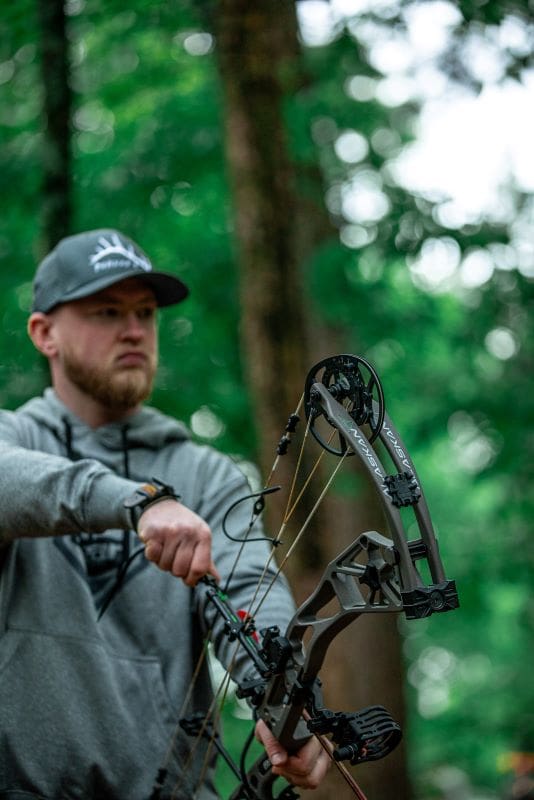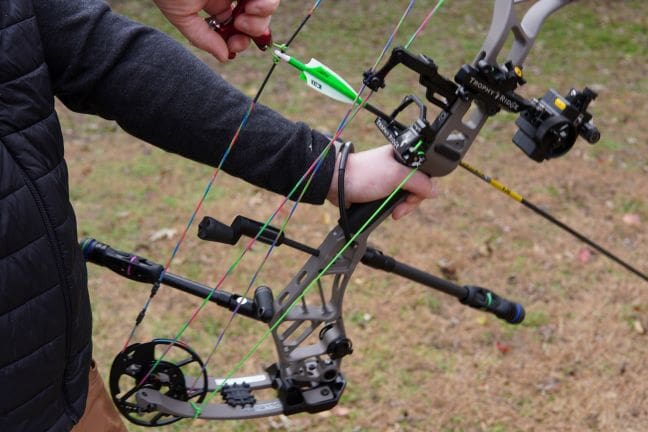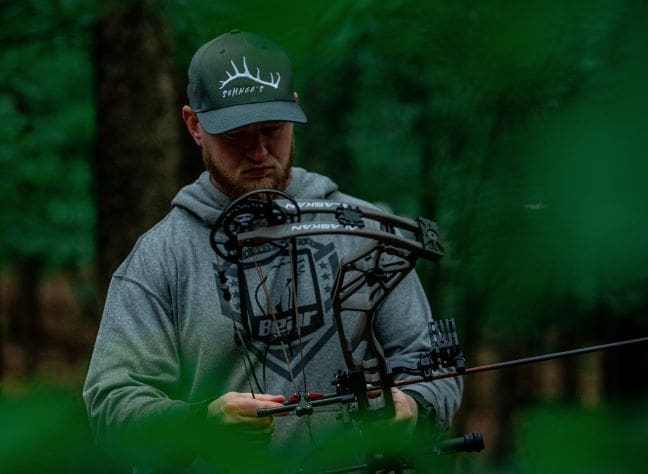Responding to a help-wanted sign at a local archery pro shop was the first step in a thrilling journey for Dylan Ray, the archery pro and host of The Bear Archery Podcast. His passion for bowhunting and all things archery ignited during his college years. A quick reply to a job posting at Norman Archery in Oklahoma led to a role packing and shipping orders, but Dylan’s path quickly turned to working directly with the bows. “It was the perfect gig to get my feet wet,” Dylan recalls. “I learned to tune bows, tie D-loops, install peep sights, and handle anything else that came my way.”
Years later, Dylan has become a go-to resource for archery enthusiasts, sharing his expertise through engaging video content and insightful interviews on his popular podcast. I recently caught up with Dylan to tap into his vast knowledge of archery and get some top tips on tuning your bow and arrows for peak performance.

Wood: How important is tuning your compound bow and arrows?
Ray: A compound and recurve are two different ballgames; with a recurve, I often tell shooters they must have an arrow that will shoot out of that bow. Yet, with a compound bow, you find the arrow that best suits your bow, then marry the two together. With compounds, it is a science. If you shoot an arrow at a deer, and it hits it sideways or flies crooked, it will not be good. You want your arrow to fly as straight as possible to penetrate an animal best.
One of the most significant mistakes hunters make is having an arrow that is under spined. Most archery shops stock an arrow size of 340s or 400s because it is the most popular size, and sometimes people shoot the wrong arrow. Pushing a stiff object through an animal is easier than flimsy, so I often suggest using a stiffer arrow. I can tune any arrow too stiff to any bow, so find the stiffest arrow that will fly well out of your bow.
Wood: How does a shooter find the right arrow for them?
Ray: I firmly believe that every shooter should listen to every stance. Right, wrong, or indifferent, then build their own belief system. Many shooters think heavy arrow shooters are a joke; some only like light arrows and mechanicals and think the big heavy contact arrows are silly. Listen to both sides of the story and formulate your opinion afterward.
Arrows do have a point of diminishing returns. In other words, you are stacking up more kinetic energy than you will ever need at the expense of speed, which is crucial. I am not a speed guy; I want a hard-hitting arrow, yet I don’t want to go to the extreme that I sacrifice enough speed so that the animal has more time to duck or jump the string. I suggest you spine up and add weight to the front of your arrow. I like an arrow weight of 500 grains. 475 is not too light, and 525 is not too heavy. If you go above 525, you often sacrifice speed for more kinetic energy than you will ever need.
Wood: What type of broadhead is the best?
Ray: I shoot heavy, cut-on-contact broadheads; I am a fan of single bevels and double bevels with bleeders; it depends on what animal I am hunting. The reason I say that is because a double bevel has bone-breaching abilities, yet it only offers one slit through the animal. You never have anything that disrupts that cut. If hunting an animal such as a bear or a wild pig, which are known for not bleeding well when hit, then I go with a double bevel broadhead with a bleeder to produce more blood.
Wood: How do you tune your arrow to your bow?
Ray: I will ensure the bow is in spec out of the box. What I mean by that is that I measure axle to axle and brace height. When strings stretch, your bow can be out of spec, so beginning with a bow that measures accurately is essential. If it is not spec, tuning your bow is impossible. Next, I put my rest on, whether a whisker biscuit or drop away, set it up, and get everything center shot at 13/16 from the shelf. Then, I ensure it is in time, meaning that the top and bottom cam are hitting simultaneously. After everything is in line, I will shoot at the paper with bare shafts, with no fletching. Many hunters skip directly to fletched arrows; the reason you want to start with bare shafts is that if the shaft is flying good from the beginning, the vanes don’t have to do as much fighting to fly well, and it is going to fly better. If the bare shaft flies well, I will have a better flying and quieter arrow. Start shooting bare shafts at a paper at three yards and get it punching a perfect bullet hole. Next, I shoot at twenty yards and make sure the arrows fly straight. If the bare shafts and fletched arrows are both hitting good at twenty yards, I am ready to rock and roll.
Wood: Is a faster arrow a misconception from hunters?
Ray: 100% speed is misleading to hunters. A bowhunter should only have a super-fast arrow when hunting antelope. If you could only build one hunting arrow to shoot everything else with, I think, elk, I build the arrow for that, then I use that arrow for everything else I hunt. Because if it will take down an elk, why wouldn’t it take down a whitetail? I hear many hunters say, I shoot mechanical broadheads for whitetail because they have a giant hole, but when they hunt elk, they want a cut on contact broadhead. Well, if the big contact broadheads are going to take down the elk, why wouldn’t they take down a whitetail?
A hundred different things can go wrong when bowhunting big game. Dylan Ray says that we, as archers, must never forget that the animal always has a vote. “We can’t control what happens down range. When I let the arrow go, I can’t control if that animal jumps, twists, or ducks. Yet, I know the only thing I can control is that my bow and arrow are ready and that I make and take the most ethical shot. That comes from having everything tuned well and practice”.


